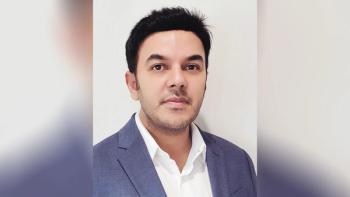
- Pharmaceutical Executive: August 2025
- Volume 45
- Issue 6
An RNA-Guided Path
Key Takeaways
- Samir Ounzain's research on the dark genome led to founding HAYA Therapeutics, focusing on precision RNA-guided medicines for fibrosis.
- HAYA targets root-cause mechanisms of common and chronic diseases, particularly fibrosis, by reprogramming disease-driving effector cells.
Powering learnings of the dark genome to tackle disease at its source.
As often the case with emerging pharma leaders, Samir Ounzain began his career in academia. According to the executive, the research he was working on at the time led to inspiration that would shape a big change in his career.
“Prior to founding HAYA, I spent my whole career as an academic,” he says. “I studied the dark genome from a basic science perspective of answering the question: how does the genome speak to the environment? During the process of that research, which was primarily focused on cardiovascular development and disease, it became very apparent that this biological target space we were unlocking had some very interesting features from a target product profile perspective.”
Now, he’s the CEO and co-founder of HAYA Therapeutics, a biotech focused on developing precision RNA-guided medicines. When asked about its origins, he focuses on the science behind the work and how he realized it could positively impact so many lives across the world.
“I think the moment where that transition or that inspiration happened was when I understood how few options there were for fibrosis, both within the heart and within other tissues,” Ounzain tells Pharm Exec. “Once we scratched the surface of why we don’t have very many medicines for fibrosis, one thing became apparent: we’re targeting individual proteins or pathways that are pretty pleiotropic.
“Those same pathways are active in different cells all over the body, which means the therapeutic windows become very small for these antifibrotic agents,” he continues. “As soon as you go into a Phase II clinical trial, you typically have problems getting efficacy, or you have safety signals because of that pleiotropic exaggerated pharmacology of the target. The dark genome and derived RNAs that we were unmasking, however, regulated fibroblast cells plasticity in only a specific tissue in a specific disease at a specific time.”
Answering an unmet need
According to Ounzain, HAYA’s objective at the highest level is to make common and chronic diseases tractable. The company does that by targeting the root-cause mechanisms that drive these common and chronic diseases. He describes this as finding out why healthy cells will sometimes convert into disease-driving states and determining whether this is due to an environmental response or if it’s happening because of genetic signals.
“The area we’ve been focusing on is in fibrosis, which is responsible for one-in-three deaths globally,” says Ounzain. “There’s fibrosis of the heart, kidney, liver, and lungs, and it really represents a pathophysiological process that results in end-stage organ failure and dysfunction. The way we get at the root of fibrosis is by reprogramming the effector cells that cause fibrosis.”
Fibroblasts, he notes, are cells in tissues that respond to environmental signals, become disease-driving, and trigger the process of fibrosis.
“Our platform and approach are based on this first principle, which is, how do cells change and respond to environmental signals?” says Ounzain. “They change by interpreting those signals through a portion of the genome called the dark genome, now recognized as the regulatory genome. About 98% of your genome is the site of information processing that allows your genome to speak to the environment and control cell states. This is where epigenetics happens, and this is where most of the genetic variation that predisposes you to these common and chronic diseases are encoded.”
The root of the matter
Ounzain spent 15 years in academia studying the regulatory genome. He realized that genetic medicines offered the opportunity to use RNA to control disease-driving cell states and processes. He says he was inspired to get into treating fibrosis due to a lack of options for patients.
“What inspired me was the relatively poor disease-modifying therapies that exist for common and chronic diseases, and the realization that that is driven not by a lack of understanding of some of the fundamental biology, but a lack of tractability of how we can intervene appropriately at the root cause to modify disease,” he says.
Ultimately, Ounzain was inspired by having an understanding, at the fundamental level, of how common and chronic diseases manifest. He then linked that understanding with the insights he and his fellow researchers were developing around the biology of cell states, and realized there was a possibility to de-risk genetic drug technologies.
“What we have now, based on work developed at HAYA over the last six years, is a suite of genetic medicine tools that are relatively de-risked,” he says. “This includes antisense oligonucleotides that can be unlocked to make cell state reprogramming tractable. The convergence of the biology, the tools, and the insights into disease progression is really what’s allowed us to reach this point. It inspires us to translate this leading-edge biology into what we believe could be near-term tractable medicines.”
Articles in this issue
4 months ago
The CAR-T Climb4 months ago
2025 Emerging Pharma Leaders4 months ago
Acceleration and Ambition4 months ago
Driving Disruption in Delivery4 months ago
Building Promise from Precision4 months ago
Determined Problem-Solver4 months ago
How to Get Product Iteration Right in HealthcareNewsletter
Lead with insight with the Pharmaceutical Executive newsletter, featuring strategic analysis, leadership trends, and market intelligence for biopharma decision-makers.




